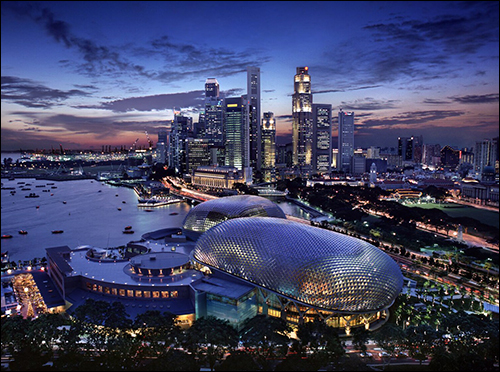Singapore has a tradition of integrating technology into its infrastructure—it was one of the first counties to use RFID-based fare cards for its public transit system, for example. So it comes as no surprise that the island city-state of 5.5 million people is heavily invested in smart-city technologies. This fall, IOT Journal sat down with Singapore’s chief information officer, Chan Cheow Hoe, to learn more about how he and his team are developing and evaluating IoT-based solutions to civic issues.
We limited our conversation to three key topic areas: transportation, sustainability and health care (particularly with regard to Singapore’s aging population). What follows is a transcript of our conversation, edited for length.
IOT Journal: Let’s start with your background. You’ve been CIO of Singapore since early 2014, but before that, you worked at the consultancy Ernst and Young?
Chan Cheow Hoe: Yes, I’ve been in the tech sector all my life, but am very new to government. It’s a big switch—such a big change.
IOT Journal: What brought you to it?
Chan: A mid-life crisis [laughing]! No. At a certain point of time, [I felt that I] wanted something different. But also the people from government told me that they wanted someone from outside, someone with a fresh pair of eyes. You’re able to really question the way things have been done. I’m open to things that we could do better [in government].
For me, it’s about impact. In the private sector, it’s about making money. But when you’re in the government, you realize that there are a lot of things that you can impact, and if you do the right things, it really does benefit the right people. I think, all of the sudden, you realize there is more to life than making money.
IOT Journal: In how much of your day-to-day job are you working on projects related to the IoT?
Chan: The IoT is really nascent and evolving, so how you define it changes all the time. Really, almost everything we do in the government connects to IoT. The big thing with IoT is really about connecting devices to the core infrastructure. So we’re building what we call a smart nation platform and we’re seeking to connect everything. IoT is really general, and can encompass anything from a TV to sensors to cameras.

Let’s start with transportation. Like any island nation, [transportation] has always been a big issue in Singapore. One thing that becomes apparent is that most countries try to build their way out of the problem. You build more roads, train lines, more infrastructure. But it’s getting impossible to do that in Singapore, so the focus is more about optimization. How can we make better use of the existing infrastructure? Whether you’re talking roads or train lines, utilization is actually pretty low. There are two peak hours in the morning and at night, where they are at 150 percent capacity, but then in the middle of the day it’s like 30 percent capacity. So how do you optimize the use of the infrastructure? That is where IoT comes to the plate.
Many people in Singapore take busses, which are efficient except that when going from point A to point B, you might have to make 25 stops. That is how it’s designed. Is that a good thing? Well most people do not want have to make so many stops, it can take an hour to get to work. So one of the things we did is use big data, based on the RFID fare cards, which gives us information on all the journeys—what time individuals get on the bus, how far they travel, where they get off. And when our guys analyzed the data, they found a logical congregation of people going from one point to another, so this how we decided to start what we call a Beeline service. With that, if you have 80 people who want to go from one point to the next, they go direct. It became quite popular.
IOT Journal: So these are essentially express bus routes, but provided by private shuttle companies, and users book the rides using the Beeline smartphone app, so that routes and timetables are activated by community demand?
Chan: Yes, it is dynamic, because it is based on the way people move [which changes over time] and suggests routes that are economically feasible for the bus companies to run. So that’s one example of how we use data. A lot of the IoT is about data, and I think that is something that people do not realize. Most of the time, it’s about how you use data to optimize certain things. We use data as much as we can to get people away from driving.
IOT Journal: We recently read about an autonomous car pilot program in Singapore, whereby individuals will be able to hail driverless taxis with their smartphones. It sounds like you’re trying to beat Uber to the punch in getting those cars on the road.
Chan: It’s a limited trial at the moment. AVs [autonomous vehicles] are a big thing at the moment, and there is a presupposition that autonomous vehicles will increase efficiency. I think that one of the things about AV [that people do not talk about] is that it’s also about the last mile. In any urban environment, one of the big problems is that you go from one station to another station, but getting from the station to your workplace or house is difficult. So our AV pilot is evaluating whether these vehicles can actually serve the last mile, and I think that is going to be quite useful.
IOT Journal: How are you going about the AV trials?
Chan: It’s a very small project [with just a few vehicles] and the legal aspects [of allowing autonomous vehicles on the roads] are still being worked out. The legal aspects of it are complex—and, in particular, the liability structure is quite complex.

The government is encouraging and funding the pilot, but the trials are being done through MIT Labs, which operates its largest research and development lab, outside of its home base in Massachusetts, in Singapore.
IOT Journal: How does transportation fit into Singapore’s goals around environmental sustainability? Are there specific mandates or carbon emissions goals?
Chan: [Singapore is a signatory to] global treaties to reduce carbon emissions. So we have to improve emissions standards for transportation. I don’t think AV [taxis] are the panacea, but moving away from [individually owned] cars is a big part of what we call the “car light” movement. It is going to help a lot.
IOT Journal: What about the built environment?
Chan: More and more people are using IoT sensors to better manage energy inside buildings, and the power savings are huge. In Singapore, because it’s so hot, the biggest user of energy is air conditioning. So there are a lot of startups right now that sell control systems and sensors that automatically regulate energy use inside buildings, based on need, or occupancy.
Because [conventionally controlled] air conditioning is really dumb, it just blasts cold air into rooms. But [sensor-based] systems use algorithms to blow cold air only where it’s needed. And these systems are showing up to 40 percent savings. They install these systems for free and then the customer pays based on how much they save in their energy costs—so that business model is like guaranteed success.
There are a couple large builders in Singapore that are installing these smart HVAC systems, and they’re being put into around a quarter of all new buildings right now.
IOT Journal: Singapore has a shrinking population, so aging and health care are big issues because the number of aged citizens who need care is outpacing the rate at which the workforce is growing. How is Singapore using the IoT to address those issues?
Chan: This issue, where birth rate is not as high as the replacement [death] rate, is probably one of the biggest problems developed countries are facing. This leads to a lot of problems for Singaporeans, and higher health-care costs is one of those [problems].
IOT Journal: Is that because as you age you are more likely to live alone and without a constant caregiver?
Chan: Right. The irony is that even though we live in an increasingly dense community, more people are living alone. But we realized that communities are growing around the mobile phone, as people use What’sApp, Instagram, etc. So what we are trying to do is use the phone as a way to connect people. We created an app called MyResponder. It is a simple way of crowdsourcing lifesavers. Anyone with medical experience [such as nurses, EMTs or doctors] can volunteer to join the network as a lifesaver. When an individual is having a medical emergency and they [or bystanders] call emergency services, the Singapore Civil Defense Force will notify everyone using the MyResponder app within a 400-meter radius [of the patient]. So if you get an alert saying this person has collapsed at this location, you can use the app to say that you are on your way. The app also shows the responder the location of nearby AEDs [automated external defibrillators].
IOT Journal: The Civil Defense Force also dispatches an ambulance, but MyResponder users might get to the patient first?
Chan: Yes. And there are close to 10,000 volunteers using this app—and it is only a year old. It has saved a lot of lives.
My team has also created a [prototype] called the smart walking stick. As people get older, they might get lost and not be able to find their way home, or they might fall and not be able to get up. So what my team has done is to build an accelerometer and GPS tracker inside a walking stick. So when an older person is out walking around, the caregiver could see [on a smartphone] where the person is. And if the walking stick should fall to the ground—and remain on the ground for a period of time, indicating that they have not just dropped it—the system considers it a fall [and can dispatch help to the user’s location]. And we are piloting it right now. I think it’s promising because old people do not wear things like Fitbit bands, but if you integrate technology into a walking stick, they are more likely to use it.
We’re also playing around right now with a smart wheelchair, which can be operated autonomously, so in a hospital a patient could be sent from one place to another without needing someone to bring them there. They are also testing the wheelchair in museums as well. These are all really interesting initiatives. Once these ideas get to the point where they could be commercialized, we find companies who could do that.


